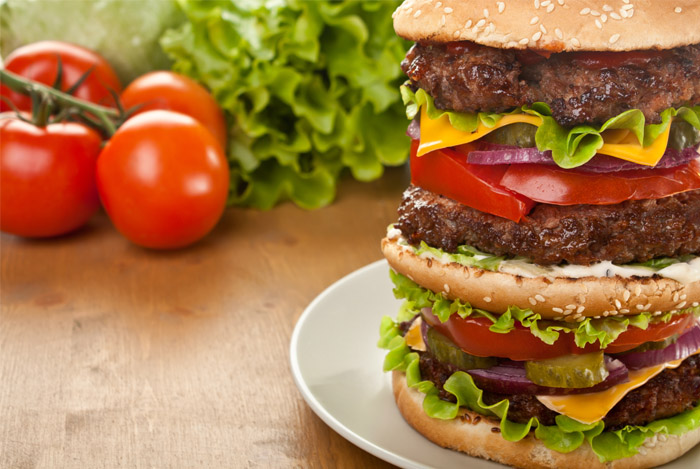If you live in the United States, you’ve likely heard talk of how huge our portion sizes are. If you live outside of the United States and have been here before, you’ve probably noticed for yourself.
And maybe, as an American, you’re proud of how much food you have access to. When it’s time for you to eat, maybe you’re happy you can pile as much food on your plate as you wish.
What you may not know is how absolutely awful this is for your health over time. And, because it’s been such a popular trend in this country to increase the portions of our food for the past few decades, many Americans have started to suffer for their overeating.
So, let’s look further into portion sizes – how they’ve grown, why they’ve grown, and what we can do to address the problem.
Foods with Largest Portion Increases

As restaurants in the United States have proliferated over the decades (a 75% increase), the amount of food accessible to Americans has increased tremendously. And when we go to these restaurants, we have a tendency to overindulge.
A lot of this has to do with how cheap and convenient many of these establishments are. When you can easily drive through a McDonald’s at the end of your day instead of going home to prepare a healthy meal it’s easy to see why so many people fall prey to fast food.
This is one of the most significant contributing factors in the obesity epidemic. Studies have shown that as the frequency of going out to restaurants and consuming those food options increases, body fat increases too.
And you’d better believe the portions in these establishments have increased over the years.
Even if you’re not the type to go out to restaurants on a regular basis, you’re still confronted with huge portion sizes of foods that are prepackaged, convenient, and ready-to-eat. Portion sizes of these foods have been increasing for decades, and they now exceed most federal serving size standards.
According to the CDC, certain foods have taken larger roles in our diet. They are also on average higher in calories than they once were.
Here are a few examples of these foods:
- Salty snacks (93 calories higher)
- French fries (68 calories more)
- Desserts
- Soft drinks (49 calories more)
- Fruit drinks
- Hamburgers/Cheeseburgers (97 calories)
- Pizza
- Mexican food (133 calories more)
From 1977 to 1978, these unhealthy sorts of foods represented 18% of the calories consumed in the United States. That number increased from 1994 to 1996 to 27.7%.
What Has Caused the Increase In Portions?
 It may be hard to pinpoint exactly what has caused our portion woes, but a lot of it can be explained by our hyper-consumerist culture.
It may be hard to pinpoint exactly what has caused our portion woes, but a lot of it can be explained by our hyper-consumerist culture.
When we purchase something, we want to get the biggest bang for our buck. When it comes to food, we want the most out of the meal.
Once, this might have been a way of appreciating the idea of taking a meal home for seconds or eating those seconds the next day for lunch. Now, the idea of seconds is only considered when we are so full, eating another bite seems impossible.
Today, we don’t like the idea of being shortchanged. When someone buys a burger, it had better be the biggest burger imaginable. This is called “value sizing”, and it’s one of the reasons why eating challenges have become so popular at novelty chain restaurants. These establishments offer insane amounts of food with the caveat that you will only have to pay for it if you cannot eat everything on the plate.
And we eat this kind of thing up. There are even television programs devoted to eating the unhealthiest foods imaginable, and where to find them.
How Much Should We Be Eating?
 According to the USDA, the average moderately active female should be consuming around 2,000 calories a day. A moderately active male should be consuming 2400 to 2600 calories.
According to the USDA, the average moderately active female should be consuming around 2,000 calories a day. A moderately active male should be consuming 2400 to 2600 calories.
Spread across three meals, that means portion control is of the utmost importance if you care to meet those estimated standards.
But because of how massive these portions have become at these restaurants and on the average American plate, your chances of ever falling under that recommended calorie amount (a good thing if you’re looking to lose weight, creating a negative energy balance) are slim.
One way you can find balance after you find you’ve eaten a massive portion is by controlling what you eat for the rest of the day. If you have a large lunch, have a far smaller dinner – and cut out the unhealthy snacks in-between.
Unfortunately, this is not always easy. Studies have shown that people eating larger portion sizes did not notice the increased amount of food they consumed, and continued later to eat a normal amount of food in subsequent mealtimes.
The smartest way to address this issue is by sticking to serving sizes. This may is difficult to do if you’re at a restaurant since most never even tell you how many calories are in the meal you’re ordering. But, if you’re eating at home, you have far more control.
When you pop the top off a can of soup or tear open a bag of chips, look at the nutrition label and see what the recommended serving size is. I know, sometimes they can seem ridiculous – it’s hard to only eat 11 chips – but that is simply a reflection of the sort of food you’re buying.
If you want to get fuller while eating less, change your diet. There are all sorts of high-protein foods you can include in your diet that will fill you up without weighing you down.
If you stick to eating smaller serving sizes, ignoring your eyes that may be bigger than your stomach, you’ll find that you’re just as energized. After a while of practicing this, you may even find that you’re satisfied with smaller amounts of food.
How Have Increased Portion Sizes Affected Us?
 When portion sizes increase, we tend to eat more. A study published in the American Journal of Clinical Nutrition found that regardless of whether they tested men, women, dieters, or non-dieters, everyone ate more when portions were increased.
When portion sizes increase, we tend to eat more. A study published in the American Journal of Clinical Nutrition found that regardless of whether they tested men, women, dieters, or non-dieters, everyone ate more when portions were increased.
As portion sizes have increased, there has also been a parallel with increasing body weight.
This, of course, is obvious. Eating more food means our bodies are required to process or make use of more energy. If that energy has nowhere to go, it’s stored as fat.
The number of overweight and obese people has increased dramatically over the past few decades. While weight gain can be attributed to multiple factors, it largely comes back to that simple fact: the more you eat, the fatter you become.
The National Heart, Lung, and Blood Institute lays out a perfect example of how our daily meals have increased.
If your average day consists of:
- Breakfast: a 6 inch bagel and a 16 ounce coffee with milk and sugar.
- Lunch: two pieces of pepperoni pizza and a 20-ounce soft drink.
- Dinner: a chicken Caesar salad and a 20-ounce soft drink.
In that one day, you would be consuming 1,595 more calories than you would have eaten for the same meals if they were served 20 years ago.
Now imagine you do that every day over the course of a year. What if you did it every day over the course of a decade?
Many Americans are doing this. And it isn’t always because they’re enjoying throwing caution to the wind; some simply don’t realize what they’re doing to themselves. Or worse, they are children being fed these portions by their parents.
Though, to be honest, I don’t actually know any children who eat bagels with coffee or Caesar salad. Normally it’s sugary cereal and cheeseburgers. No wonder our kids are suffering more from diabetes and other weight-related illnesses.
In fact, diabetes is beginning to affect Americans at a greater rate than ever before. If the current trend continues, by 2050 1 in 3 Americans will suffer from the disease. It’s no surprise considering the average portion size and diet of people in the United States.
How to Combat Increased Portions
 For what has likely been centuries, parents have been telling their children to clean their plates. This made sense when food was a resource you might not come across again for a few days.
For what has likely been centuries, parents have been telling their children to clean their plates. This made sense when food was a resource you might not come across again for a few days.
But today, modern societies across the planet no longer have to worry so much about where their next meal is coming from.
Telling your children repeatedly to clean their plates may have negative side effects. It could lead, in the short term, to feelings of comfort and reward after having eaten more than they should have. In the long term, it could lead to eating disorders and health problems.
It’s better to put less food on your plate and want more later than to put too much food on your plate, eat all of it, and come to regret it. The same goes for children, parents do not need to pile food onto their plates. Let them determine how much they want to eat. Let your children know what it feels like to be full and that it’s okay to stop eating.
You can also get crafty with your mealtimes. Some examples include:
- Smaller plates: Instead of using larger plates with greater surface area to coat in food, use smaller plates. If you’re using a bowl, don’t fill it to the brim.
- Savor your food: If you eat slowly, studies have shown you feel fuller, quicker.
- Make substitutions: Instead of eating a ridiculous portion of one food, eat a small amount accompanied by a salad or other vegetable. A myriad of studies show benefits for eating more veggies.
- Eat more protein: Studies have shown that eating diets with higher protein content can help you eat less while feeling fuller.
- Get used to leftovers: To-go boxes aren’t just there for show. If you get a huge plate at a restaurant, get excited about the fact that you can eat that same meal twice. If you don’t know if you can control yourself, ask for a to-go box when your food arrives.
So, what if you know about all this but still love eating huge portions?
Then you’d better get used to exercise. If you exercise every day, you’ll be burning a significant chunk of those calories away. If you play sports regularly, then you’ll really deserve that huge dinner.
Remember what I said about the USDA calorie recommendations? Olympic gold medalist Michael Phelps required nearly six times the recommended amount.
But, odds are, you aren’t training and performing at the same level as Michael Phelps. You’re probably a regular person with regular caloric requirements. So please, avoid those huge portions.
Educate yourself further to the pitfalls of eating whatever you like, whenever you like, and however much of it you like. Stick to the serving sizes. Your body will appreciate it.
Have you noticed the increase in portions over the years? What have you done to account for it?
The post Disastrous Over Eating: How Portion Sizes Have Changed Over Time appeared first on Nutrition Secrets.
http://www.nutritionsecrets.com/over-eating/
No comments:
Post a Comment